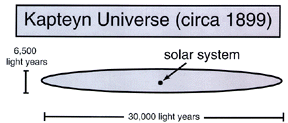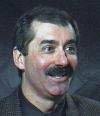Growing CosmologyBefore describing the basics of our view of the universe circa 1999, it is interesting to reflect on how much our view of the universe has grown in the twentieth century. One-hundred years ago an astronomer would have probably described the universe as a flattened disk, thirty-thousand lightyears in diameter and six-thousand-five-hundred light-years thick, with our solar system located "at or very near" the center. This model universe, named the Kapteyn Universe after the Dutch astronomer Jacobus Cornelius Kapteyn (1851-1922), does not extend beyond our own Milky Way galaxy. In 1918, the American astronomer Harlow Shapley demonstrated that we do not live in the center of the Milky Way, and in 1924 another American astronomer, Edwin Hubble, proved that just as our sun is just one of billions of stars in our home galaxy, the Milky Way was just one of billions of galaxies. After the second discovery of Hubble, we realized that the universe is of far greater proportions than imagined in 1899.
Figure 1: The Kapteyn Universe Not only did Hubble extend our cosmic horizon to encompass billions and billions of galaxies beyond the Milky Way, but his 1929 discovery of the expansion of the universe was the first of two great cosmological discoveries of the twentieth century. The second great discovery was in 1964, when Arno Penzias and Robert Wilson discovered the existence of a cosmic background of radiation. We now understand that the cosmic background radiation, currently at a temperature of about three degrees Kelvin (3 K) above absolute zero (equivalent to -270oC or -454oF), is the remnant of the hot radiation from the early universe. The discovery of the expansion of the universe and the observation of the cosmic background radiation are the cornerstones of our modern model of the universe, the big-bang model. The body of evidence supporting the big-bang model is so overwhelming that it is impossible to escape the conclusion that the universe was once denser and hotter than it is today. We no longer question that the big bang is a good description of the universe for most of its history. The real question is how far back we can extrapolate the big bang. When (if ever) will the big-bang model fail? Can we trust the big-bang model under the extreme conditions near the time of the big bang? Let's journey through the complete history of the universe, running the film of the big bang backwards, pausing occasionally to examine the conditions we encounter.
Contributed by: Dr. Edward Kolb |






